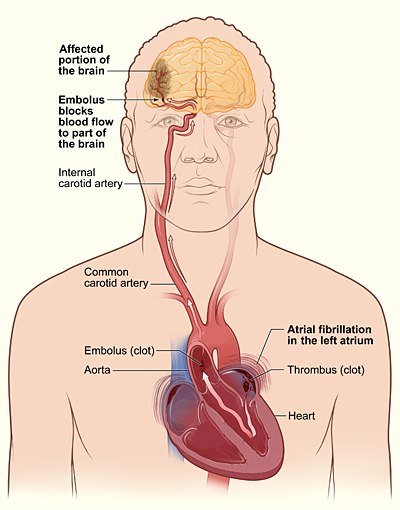What Are the Signs and Symptoms of Atrial
Fibrillation?
Signs and Symptoms
Atrial fibrillation (AF) usually causes the
ventricles to contract faster than normal. When this happens, the ventricles
don’t have enough time to fill completely with blood to pump to the lungs
and body. This inefficient pumping can cause signs and symptoms, such as:
- Palpitations (a strong feeling of a fast
heartbeat or a “thumping” in the chest)
- Shortness of breath
- Weakness or difficulty exercising
- Chest pain
- Dizziness or fainting
- Fatigue (tiredness)
- Confusion
Complications
AF has two major complications—stroke and
heart
failure.
Heart
attack is another, rarer complication.
Stroke
During AF, the atria don’t pump all of their
blood to the ventricles. Some blood pools in the atria. When this happens, a
blood clot (also called a thrombus) can form. If the clot breaks off and
travels to the brain, it can cause a stroke. (A clot that forms in one part of
the body and travels in the bloodstream to another part of the body is called
an embolus.)
Blood-thinning medicines to reduce the risk of
stroke are a very important part of treatment for patients who have AF.
Atrial Fibrillation and Stroke

The illustration shows how a stroke
can occur during atrial fibrillation. If a clot (thrombus) forms in the left
atrium of the heart, a piece of it can dislodge and travel to an artery in the
brain, blocking blood flow through the artery. The lack of blood flow to the
portion of the brain fed by the artery causes a stroke.
Heart Failure
Heart failure occurs when the heart can’t pump
enough blood to meet the body’s needs. Because the ventricles are beating
very fast and aren’t able to properly fill with blood to pump out to the
body, AF can lead to heart failure.
Fatigue and shortness of breath are common symptoms
of heart failure. A buildup of fluid in the lungs causes these symptoms. Fluid
also can build up in the feet, ankles, and legs, causing weight gain.
Lifestyle changes, medicines, and sometimes special
care (rarely, a mechanical heart pump or heart transplant) are the main
treatments for heart failure. |

